New Jersey to Florida and Return
Page 3 - The Return Trip
 We stayed overnight in the
Kennedy Space Center Holiday Inn located 3 miles north of the
KTIX airport on Route 1. This is the view off the balcony of my
room.
We stayed overnight in the
Kennedy Space Center Holiday Inn located 3 miles north of the
KTIX airport on Route 1. This is the view off the balcony of my
room.
At this location, we're only a few miles from Merritt Island and the Shuttle Launch and Landing facilities. This is a perfect location to view shuttle launches. For this reason, the hotel staff told us that they usually sell out 2 months in advance of launches. The room prices are also far higher than we paid (what a surprise).
Also notice the clear indication that we're not in Kansas (ahem, I mean, New Jersey) anymore. Palm Trees. The weather leaving New Jersey? Sunny and 45 degrees with a cold wind blowing. The weather in Florida this morning? Wonderfully sunny, muggy, and 65 degrees with a forecast high of near 80. Guess that's why they call it paradise.
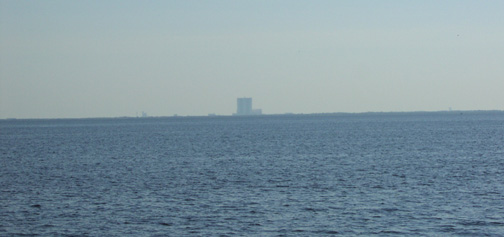 Here's a closeup
(well, a closeup without getting wet) of the Assembly Building,
which I last visited only in passing on a tour in 1986, shortly
after the Challenger accident. I really didn't get to see much
then, including the launch facilities, since they were still
closed during the accident investigation.
Here's a closeup
(well, a closeup without getting wet) of the Assembly Building,
which I last visited only in passing on a tour in 1986, shortly
after the Challenger accident. I really didn't get to see much
then, including the launch facilities, since they were still
closed during the accident investigation.
I had wanted to do what the local air traffic controllers call a "shuttle tour", which amounts to a low-level fly-by of the shuttle landing facility (a 3 mile long runway) and a pass by the launch facilities, but courtesy of those F$%!%! terrorists, Daytona Beach approach indicated shuttle tours were "not available at this time". And, no, I didn't ask. I overheard someone else on frequency waste their time.
In fact, NASA was so paranoid about an attack on the shuttle (ST-108 was getting ready to launch at this time), that they reportedly stationed surface to air missle batteries on the island and required all aircraft arriving or departing various local airports, including KTIX, to have a discrete beacon code (VFR included). Of course, we filed IFR so ATC would have no confusion as to our intentions.
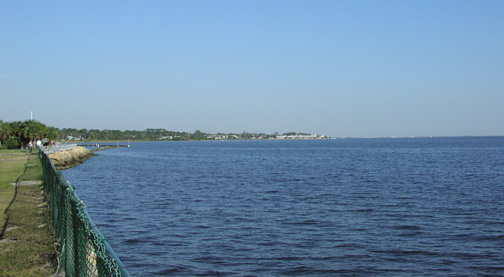 Okay, okay...this is
not exactly an aviation-related picture, but it just looked so
damn nice that I had to post it. This is looking north from a
grass-covered observation area. Merritt Island is to the right.
This is apparently where everyone staying at the hotel stands
to watch the launches.
Okay, okay...this is
not exactly an aviation-related picture, but it just looked so
damn nice that I had to post it. This is looking north from a
grass-covered observation area. Merritt Island is to the right.
This is apparently where everyone staying at the hotel stands
to watch the launches.
Notice that there's not much of a traditional beach coast here...climb over that fence and you're in the drink.
Incidentally, this is the closest thing to a real vacation I've had in about 7 years. I savored the 10 minutes it took me to take these pictures. Yes, I'm a pathetic workaholic. Wanna make something out of it?
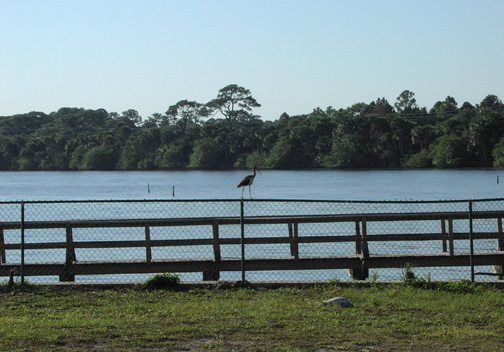 Come on...you didn't expect a
photo essay of a trip to Florida to NOT include a wildlife
photo, did you?
Come on...you didn't expect a
photo essay of a trip to Florida to NOT include a wildlife
photo, did you?
So here's the obligatory wildlife photo. Hope you like it.
Back to work (ahem, I mean "play").
After dealing with a few last minute maintenance issues like a failed gasolator drain actuator seal, which was leaking fuel from the top of the gascolator, I picked up a last-minute check of the weather and notams from St. Petersburg Flight Service.
I figure I'll take this time to say that the female FSS specialist I spoke to was really friendly and had a good sense of humor. Sometimes a simple laugh can help allieviate tension like that which affects any pilot before a long flight with lots of unknowns, and our brief chat did just that. I was irritated by a few things at the time and she made me forget all that and put me in the right frame of mind to fly. No matter how much I use DUAT, I'll always see the need for friendly HUMAN Flight Service Station specialists. To that specialist: THANKS!
Anyhoo, the first leg of my trip northbound from KTIX to KCRG was largely spent occupied flying the airplane (hence no pictures). During this leg it struck me as odd that an airplane with which I was so familiar at one point was now markedly different for various reasons. I'll choose to avoid detail, but I wrote up 14 squawks on the way home...and this in a (then) well-maintained airplane. Moral? Never trust an airplane no matter how well you think you know (or in my case, knew) it.
I'll liken this experience to seeing an old girlfriend with whom you were once totally, hopelessly, (and perhaps more to the point), blindly in love at one point, but now doesn't exactly "light your fire". Fortunately, as I grew to understand the current state of this old friend, I learned to accept her faults and work with her. By the end of the trip, in spite of the fact she threw me a curve ball on the final leg, I have to admit I felt like I was in love again, only with the benefit of experience and a pre-nup agreement in hand. Eh. They call it growing up. But, I digress...
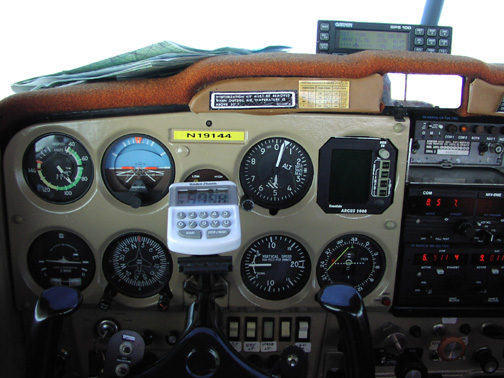 Here we
are enroute between Brunswick, Georgia VORTAC and Savannah,
Georgia VORTAC on V3 at 5000 feet, indicating 94 Knots and
truing out at around +10 K (104KTAS) -- yea, I know...the
airspeed indicator shows 91 Knots at this point, but I was in a
slight downdraft...honest). Incidentally, the old rule of thumb
to obtain True Airspeed (add 2 knots per 1000 ft to KIAS),
works pretty well.
Here we
are enroute between Brunswick, Georgia VORTAC and Savannah,
Georgia VORTAC on V3 at 5000 feet, indicating 94 Knots and
truing out at around +10 K (104KTAS) -- yea, I know...the
airspeed indicator shows 91 Knots at this point, but I was in a
slight downdraft...honest). Incidentally, the old rule of thumb
to obtain True Airspeed (add 2 knots per 1000 ft to KIAS),
works pretty well.
I was pushing it a bit hard because of a new cylinder that hadn't broken in yet, so I was making OPEC happy, but naturally, I planned short legs in anticpation of this.
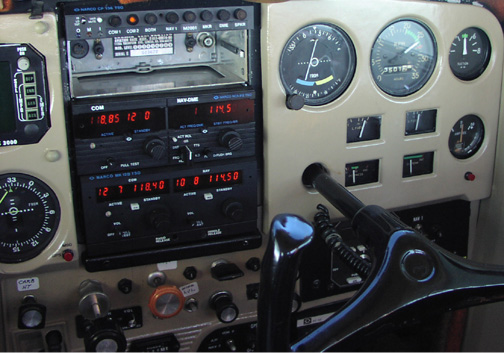 What can I say...this
is a pretty damn well equipped Cessna 150, but unfortunately
very little of this fancy gear was working on this trip, save
for the autopilot (and given the planned 10 hours of flight
time, thank GOD for that).
What can I say...this
is a pretty damn well equipped Cessna 150, but unfortunately
very little of this fancy gear was working on this trip, save
for the autopilot (and given the planned 10 hours of flight
time, thank GOD for that).
If you're wondering why I have the GPS on the glareshield instead of in its tray, that's because I found some sort of fault in the GPS tray or antenna which not only prevented reception of the GPS signals, but also killed communications between the GPS and the Argus 3000 moving map display. Hence, I ran the unit on its internal battery, in Battery Saver mode, stuck it on its charger for the duration of each fuel stop, and, of course, relied primarily on VOR navigation to get where I was going.
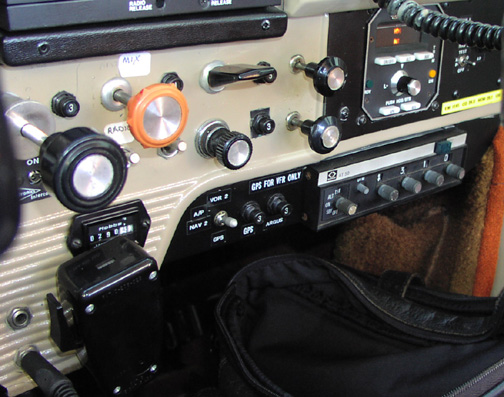 In fact,
the thing is so well equipped we had to make the passenger
responsible for entering the squawk code. :-) Above that you
can see the AWESOME S-TEC System 50 2-axis autopilot holding
our heading (HDG), and altitude (ALT). If you push the knob in
momentarily, it switches to steering mode (STB) so you can bank
left and right by moving the knob respectively.
In fact,
the thing is so well equipped we had to make the passenger
responsible for entering the squawk code. :-) Above that you
can see the AWESOME S-TEC System 50 2-axis autopilot holding
our heading (HDG), and altitude (ALT). If you push the knob in
momentarily, it switches to steering mode (STB) so you can bank
left and right by moving the knob respectively.
I love S-TEC autopilots because they're rate-based systems that do NOT depend on vacuum driven instruments. Have a vacuum failure in an aircraft equipped with a King autopilot and you're not careful, you could find yourself in a graveyard spiral. Not the case with the S-TEC unit.
When I finally buy that dream Baron of mine, you can be damn sure it will be equipped with the latest generation S-TEC autopilot.
Oh, yea, my Baron will also be equipped with dual avionics master switches...just like this little gal has. Frankly, I can't understand why the new $200K+ Cessnas have only one switch.
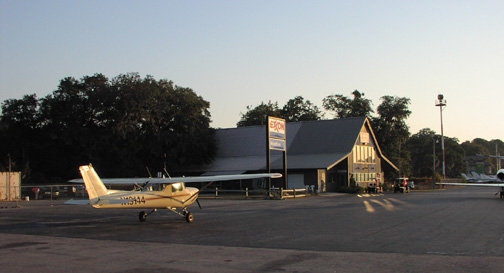 After
stopping at KCRG and falling in love with the three (count 'em
*three*) beautiful, 20-something, dressed-to-the-teeth,
girl-next-door, bring-home-to-mother, marry-for-life types that
handled my transaction at Craig Air, I flew the second leg to
Hilton Head, NC (broken hearted, of course) :-)
After
stopping at KCRG and falling in love with the three (count 'em
*three*) beautiful, 20-something, dressed-to-the-teeth,
girl-next-door, bring-home-to-mother, marry-for-life types that
handled my transaction at Craig Air, I flew the second leg to
Hilton Head, NC (broken hearted, of course) :-)
I chose this as a possible intermediate stop on the way down, but the 172's endurance allowed an overflight. Too bad, too, as on the return trip the C150's limited range allowed me to find out what a truly beautiful place this is.
I chatted with some more friendly people, and found out that the October/November timeframe is a GREAT time to come down here because all the local hotels lower their rates substantially. Granted, it wasn't exactly beach weather when I got there, but it's perfect for a quiet weekend (or a week-long) getaway. Just be prepared to mix your bug-smasher in with the jet traffic...because at HXD, the jets are a flyin'.
I had only filed flight plans as far as Kingston Regional JetPort (KISO), Kingston, NC, so before I left Hilton Head I did some additional planning. As I was pressed for time, I anticpated doing the awkward planning (folding/unfolding maps, etc.) on the ground and then do the leg times and file the flight plans for the remaining legs to NJ in the air with Flight Service...which is to say that as late as Hilton Head, I figured I would continue via Grand Strand (KGRE), Kingston (KISO), Newport News (KPHF), Wildwood NJ (KWWD), and then home this evening. The planned arrival time at my final destination was sometime shortly before midnight.
As you can tell from the last picture, by the time I left Hilton Head, the Sun was racing for the horizon. Because I got up at 5AM, and got off late due to various problems, I was tired. I HAVE flown when I was far more tired, or in less than peak physical condition, but as I took off and the Sun set, I began thinking about the practicality of flying late at night...limited fuel and services, and the worst-case scenario that a maintenance problem at 11PM at some deserted airport might result in sleeping with the aircraft. After I gazed up at the milky-way and picked out a share of constellations, I figured I would stop in Grand Strand and get a room.
Boy, am I ever glad I did that. The folks at Ramp66 had just sent 7 national guardsmen over to the local Marriott and got a special rate ($50/night...which is cheap for a Marriott room anywhere on the east coast...to say nothing of a resort town). Hearing of a "lonely, weary ferry pilot in need of refuge for the night" was all that was necessary for the hotel staff to give me a room at the $50 rate. Wahoo!
To make things even better, one of the line crew was on his way home and offered to drive me to the hotel, so I didn't need to arrange for a cab. I threw him a few bucks for gas, and thanked him, and went to check in. There was a Fuddruckers within walking distance (just outside the hotel), but since I arrived at 9PM, they had just closed, so I went back to the hotel and asked the receptionists if there were any good pizza joints around that delivered. They recommended one called Ultimate California Pizza and I ordered one of their "Personal Pizza" specials (8", light crust, with red sauce, green peppers, yellow onions, and mushrooms). Okay, perhaps this is too much detail, but I had to mention it because it was just about the best pizza I've ever had. I feasted while I planned for the next legs, called some family and friends on my cell phone (since my roaming charges were cheaper than the hotel long-distance rate), and then hit the sack at midnight after watching some Star Trek: NG on the Friday-night marathon on TNN. Nothing like Star Trek and Deanna Troi to relieve one's stress...
In short, I had a great evening in spite of being hundreds of miles away from home and alone this time. But, the best thing about it was that I felt that I had made the right decision regarding flying at night, even though there was nothing really preventing me from completing the flight. Little did I know at the time how important that decision would turn out to be, when I encountered a maintenance problem on the last leg of the flight. Had I continued, my "worst case scenario" would have come true.
 Of course,
nothing is perfect, and so it was when I woke up the next
morning at 6AM, fully rested. Indefinite Ceiling 0, Sky
Obscured, Visibility 0, Fog & (here's the fun part for all
you campers that have been reading since page 1), SMOKE.
Of course,
nothing is perfect, and so it was when I woke up the next
morning at 6AM, fully rested. Indefinite Ceiling 0, Sky
Obscured, Visibility 0, Fog & (here's the fun part for all
you campers that have been reading since page 1), SMOKE.
So this is the view out my hotel window that morning. If you look really closely, you can see a light pole out in the parking lot that is maybe 50 feet away. I'm not kidding. The window is not dirty...it really was this bad.
Fortunately, a call to Flight Service revealed that the TAFs for the area suggested this stuff would clear up by 8AM, and sure enough, it started to lift by then. By the time I got to the airport, shortly before 9AM, it was clear with visibility unrestricted.
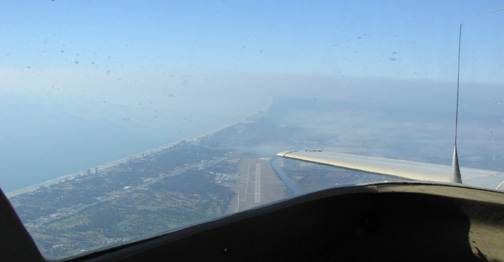 Here I
am leaving Grand Strand northbound direct Wilmington VORTAC at
9AM Saturday morning, IFR level at 5000.
Here I
am leaving Grand Strand northbound direct Wilmington VORTAC at
9AM Saturday morning, IFR level at 5000.
If you look closely, you can see the fog and smoke that persisted south of the airport. And, of course, the breathtaking South Carolina coastline is clearly visible...hotels and all.
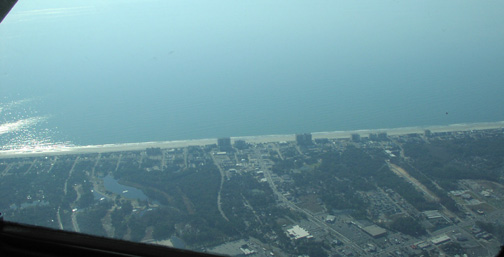 Another pic
of the coastline just a few miles north of Grand Strand
Airport.
Another pic
of the coastline just a few miles north of Grand Strand
Airport.
Notice how the ocean swells are lined up running northwest/southeast. Winds had shifted from the north to the southwest overnight, and increased in velocity, putting them nearly on my tail. Hello 100+K groundspeeds.
Someone likes me.
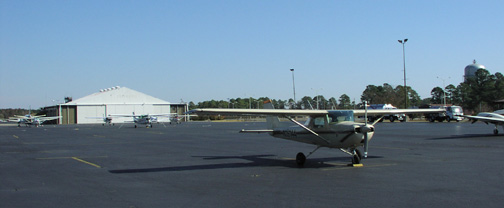 I had
originally planned to fly from KCRE to KISO, then to KPHF. I
filed a flight plan for each leg based on a somewhat
pessimistic interpretation of the winds aloft forecast and
figured that if the first couple of legs resulted in
groundspeeds equal to or greater than the plan, I would be able
to overfly KISO and ask ATC to change my destination to
KPHF.
I had
originally planned to fly from KCRE to KISO, then to KPHF. I
filed a flight plan for each leg based on a somewhat
pessimistic interpretation of the winds aloft forecast and
figured that if the first couple of legs resulted in
groundspeeds equal to or greater than the plan, I would be able
to overfly KISO and ask ATC to change my destination to
KPHF.
To make a long story short, for some reason the ship did not seem to be pulling much, if any, fuel from the left tank. It continued to read "Full" while the right tank level decreased at a rate that I know to be consistent with the total fuel burn of the powerplant...SO, rather than even remotely risk fuel exhaustion, I decided to put it down at KISO after all and check things out.
I didn't find any contamination in the system and everything drained cleanly. The left tank didn't drain as quickly as the others, but I did recall that to be the case many years earlier.
That problem averted for the meantime, I noticed another...the nosewheel was low on air. At this point I just figured it had a slow and manageable leak. The line crew brought out their can of air and pumped it up. Problem solved...or so I thought.
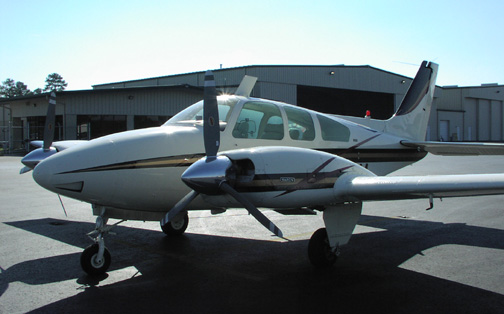 Hey,
what's this doing here. This is a story about a 172 and a 150.
Not a <drool> B55 Baron that does about <droooool>
185 Knots.
Hey,
what's this doing here. This is a story about a 172 and a 150.
Not a <drool> B55 Baron that does about <droooool>
185 Knots.
Well, I took this pic to use as a reference for a paint scheme (I really like these new Cessna-esque paint schemes), and because the aircraft was for sale. I offered to trade aircraft with the seller but they said, ah, yea, "your 150 and about $175K". I said, uh, guess not.
Man, just look at that thing. It's the Jennifer Anniston of aircraft. Hot...hot...hot.
 Here we are at
3000 feet over the James River just south of our next fuel
stop, KPHF, Newport News, VA. I had heard that the carrier
Enterprise was coming into the Norfolk port this morning, but
couldn't see it from my route. And, of course, I hestiated to
ask ATC where it was, given the current level of paranoia.
Here we are at
3000 feet over the James River just south of our next fuel
stop, KPHF, Newport News, VA. I had heard that the carrier
Enterprise was coming into the Norfolk port this morning, but
couldn't see it from my route. And, of course, I hestiated to
ask ATC where it was, given the current level of paranoia.
The ride was mostly smooth, but I did notice a good bump on the descent from 5000 through about 3500. I also noticed the wind direction and velocity changed quite a bit. Nice shear layer.
I landed at KPHF on runway 25 and once again taxied to Rick Aviation. The stop was normal, and I once again noticed that the nose wheel tire had gone flat to nearly the same degree...maybe a little more, than last time. Line service filled it up, and I was again off, on schedule, IFR to KWWD, Wildwood, NJ, only one stop from home.
Well, Ooops. Guess that loss in nosewheel pressure wasn't as slow as I thought (or it perhaps got worse as the day wore on).
I landed at Cape May County Airport in Wildwood, NJ, and made my usual effort to keep the nosewheel off of the ground until elevator lift is insufficient to hold the nose up. When the nosewheel finally touched, I felt the nose come down farther than usual and during some light braking I felt the steering get mushy. The nosewheel was obviously flat.
I carefully made a shallow turn as I exited the active runway and taxied to the FBO that I had frequented in the past.
As I tried to taxi into a parking space, I felt the nosewheel start to shudder a bit, so I stopped well short of the parking spaces and shutdown to inspect the problem. Sure enough, the tire was totally flat. It wasn't folded over or off of the rim, but it clearly was not safe to taxi, so I dragged the airplane by the tail to the nearest tiedown and shortly after noticed someone from the FBO coming out to see what had happened.
I just happened to arrive at Wildwood at about 3PM on a Saturday, and as luck would have it, as I walked over to the hangar to ask if a mechanic was available to take a peek at my nosewheel, Tom Kurtz, Director of Maintenance at Cape May Aviation said "sure! you're looking at him!".
He happened to be working to finish another customer's Baron (what is it about the Baron theme here???) and asked if I had time to wait until he finished it. I told him, in effect, "if you have the time to fix my machine, I have the time to wait".
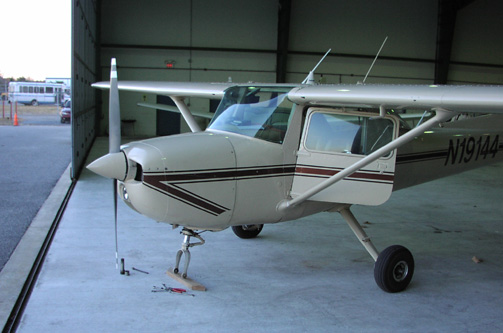 So
after a bit of walking around in the hangar gawking at all the
nice machines in there including a beautifully-restored
clipped-wing piper, a prop-jet malibu, and the other customer's
beautiful, newly-purchased 1989 B58 Baron, Tom got to work on
the nosewheel of the trusty 150.
So
after a bit of walking around in the hangar gawking at all the
nice machines in there including a beautifully-restored
clipped-wing piper, a prop-jet malibu, and the other customer's
beautiful, newly-purchased 1989 B58 Baron, Tom got to work on
the nosewheel of the trusty 150.
Tom separated the wheel, installed a new tube in a new tire, did the usual inflation dance to ensure the tube was not folded or kinked inside the tire, and then checked the condition of the rim and bearings. When all was determined to be in airworthy condition, he reassembled and reinstalled the rim with the new tube and tire and signed off the repair work in the logbooks.
After a reasonable charge of a little over $100 for tire, tube, and labor plus the fuel I had planned to buy all along, I thanked Tom for being the life-saver that he was that day, acknowledging that this was, in fact, his day off and he only had meant to come in today to work on his motorcycle...you see, all his tools are at the airport. :-)
I then departed VFR for my home field at dusk.
During the relatively brief 1 hour ride home with winds aloft of 300 degrees at 40 knots, I found myself having to establish a 30 degree crab angle to maintain my course. But, thankfully, it was perfectly smooth at 3500 feet as I called Atlantic City approach and later McGuire approach for traffic advisories and gave them a pirep. I landed at my home field, put the airplane to bed in the hangar from which we pulled the 172 two days prior, and headed home.
All in all, we logged 7 hours in the 172 and I logged 10 hours in the C150...more time than I had flown in the last several months. This was the longest flight I had ever undertaken in all of my 14 years of flying, and all things considered, I think it was a great success. It served to remind me of how very special this thing we call General Aviation is, and allowed me to appreciate the freedom it provides.



